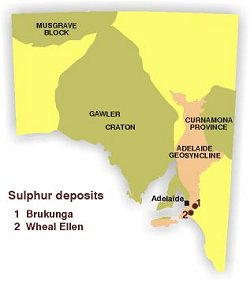 Sulfur is a widespread native element, which has been used since ancient times for medicinal and industrial purposes. Elemental sulfur occurs naturally in salt domes, as deposits around volcanoes and within sedimentary beds. Sulfuric acid, the major derivative of sulfur, is the most important inorganic chemical used in commerce, being widely used in the chemical and fertiliser industries. It has been said that sulfuric acid consumption is one of the best indexes of a nation’s industrial development.
Sulfur is a widespread native element, which has been used since ancient times for medicinal and industrial purposes. Elemental sulfur occurs naturally in salt domes, as deposits around volcanoes and within sedimentary beds. Sulfuric acid, the major derivative of sulfur, is the most important inorganic chemical used in commerce, being widely used in the chemical and fertiliser industries. It has been said that sulfuric acid consumption is one of the best indexes of a nation’s industrial development.
Primary production of elemental sulfur is mainly from salt dome cap rock deposits, which contain disseminated sulfur. Sulfur is also produced from pyrite (iron sulfide, FeS2), from soil sand deposits in Canada and recovered as by-product from smelters, industrial plants, and the refining of petroleum, oil and natural gas.
World 2013 production was 69 Mt of sulfur in all forms, of which ~50% is derived as a by-product of natural gas and petroleum production. Dedicated pyrite and native sulfur operations represent only ~30% of total production.
South Australian production
Australian production in 2013 was 900,000 tonne of sulfur as a by-product from metallurgy and petroleum. There is currently no mine production of elemental sulfur in Australia, but several metal smelters recover sulfuric acid as a by-product. In South Australia, by-product smelter acid is recovered at Port Pirie and ammonium sulfate is recovered at Olympic Dam.
Sulfuric acid is necessary for the production of superphosphate fertiliser from phosphate ore. A world shortage of sulfur in 1951 led to three South Australian fertiliser companies forming Nairne Pyrites Ltd to recover sulfur from pyrite in the Nairne Pyrite Member of the Talisker Calc-siltstone at the Brukunga Mine, 5 km northeast of Nairne in the Mount Lofty Ranges. The township of Brukunga was built to house employees, and the quarry, crushing and treatment plant began operations in 1955. About 300,000 t of ore were mined annually, and pyrite concentrate was railed to the Sulphuric Acid Pty Ltd plant at Birkenhead, a northwestern suburb of Adelaide. The Commonwealth Government underpinned the operation by agreeing to pay a subsidy if the market price of sulfur fell below a certain level, but this was abolished in 1966. By the early 1970s, cheap sulfur was being purchased from natural gas refineries in Canada, and pyrite production at Brukunga ceased in 1972. During the life of the mine 5.5 Mt of ore averaging 11% sulfur were treated for the recovery of 1.3 Mt of concentrates. Over 8 Mt of overburden and waste were removed.
The Wheal Ellen Mine situated north of Strathalbyn produced pyrite and gold from 1909 to 1912. About 5000 t of massive pyrite ore, averaging 49% sulfur, were sold for sulfuric acid manufacture. Sulfuric acid was also manufactured from gases generated by the treatment of chalcopyrite at the Wallaroo and Moonta smelters between 1899 and 1923.
The Mutorroo polymetallic Cu-Co-Fe-S vein deposit in the Olary region has a 2010 resource of 13.1 Mt at 20% S, mainly as massive pyrrhotite for 2.5 Mtonne of contained element in sulfur.
Additional reading
Sulphur, South Australia by RK Johns, 1973. Report Book, 73/260. Department of Mines, South Australia.


